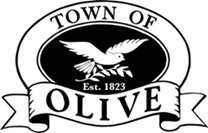History
History of The Meeting House
Brief Historical Sketch of the Olive & Hurley Old School Baptist Church
(a work in progress)
The Olive and Hurley Church is the second oldest religious organization in the town of Olive, being antedated by two months by the Shokan Reformed Church. The Society was organized September 2, 1799 as the “Tongore Baptist Church of Christ” and incorporated by a certificate executed under a date of April 29, 1811, “The First Baptist Church of Christ in Marbletown. ” At that time much of the territory now included in Olive was a part of the town of Marbletown.
This certificate was signed by Matthew Montross, moderator, and Isaac Hollister, clerk: witnessed by James Winchell; verified before Judge John Tremper; and the record attested on April 29, by Christopher Tappen, deputy clerk. The trustees chosen were James Winchell, Josiah Hollister and Stephen Bush. The meeting at which the proceeding took place was held at the First Baptist meeting house in Marbletown, or in what was known in later years as Olive City. This ancient edifice was still standing just a short time before the Ashokan Reservoir was constructed. The building was erected in 1803.
Of the men whose names are mentioned above, Isaac Hollister, who was captured by the Indians in 1763, became one of the pioneer settlers on the west side of the Esopus Creek; James Winchell, a veteran of the Revolutionary War, was a member of an old New England family and came here several years before the Revolution from Dutchess County with his brother, Lemuel, who ran the first gristmill and iron foundry in this area; Stephen Bush, of the east side of the creek was one of the Bush boys who were carried off by the Indians in 1781.
After the formation of the town of Olive, a re-incorporation of the church took place, and the new certificate was dated June 15, 1833. The notice of the meeting was given by Coenradt J. Elmendorf, “a stated hearer,” who was a veteran of the War of 1812, residing in the northeast section of the town. The presiding Inspectors of the election were Coenradt J. Elmendorf and Joseph Hollister. The trustees were Cornelius Jones, William Hollister, and Coenradt J. Elmendorf. This paper was witnessed by William Schutt, and sworn to before Edward O’Neill, commissioner of deeds.
In the early 1850’s the Church was in a flourishing condition and protracted meetings were being held which where attended by large numbers of Baptists, not only from Olive and Adjoining townships, but from Delaware and Schoharie counties, both traditional Baptist strongholds, as well. At a meeting held November 25, 1851, the men who presided as inspectors of the election were Samuel Elmendorf, a prominent farmer and mill-owner of Olive village, and Levi H. Terwilliger, a surveyor and jurist of the northeastern part of the town of Hurley. The trustees chosen were Isaac U. Every, John W. Bell and Peter Winchell. This certificate was executed December 17, 1851, verified before John B. Davis, and recorded November 2, 1853.
The meeting house in the village of Olive was now found inadequate for the large and enthusiastic services which were being held here, and plans were laid for building a more commodious structure. In 1856, a site was selected on a part of the DuBois family holdings here, on the north side of the Plank Road (State Rt.28). This was the present site of the church, which is now located in the heart of the village of Shokan, at the head of the road leading north from the head of the dividing weir of the Ashokan Reservoir. At that time there were only one or two houses for a distance of half a mile along the road at this point. On May 10, 1856, J. B. Davis surveyed the lot at the request of Jeremiah Matthews and Samuel H. Elmendorf, both of Olive village, and work was soon begun on the new building. In 1857 the church edifice was completed at a cost of $1,640.75.
In 1880, the membership of the organization being made up largely of residents of Olive and the eastern part of Hurley, it had become generally known as “The Old School Baptist Church of Olive and Hurley.” The officers of the church in 1880, one of the years in which the spacious old church yard invariably was crowded with horses and wagons upon the occasion of the “two day meeting,” were as follows: Jacob U. Every, H. Bogart, J. Matthews, deacons; Alvah Bogart, clerk; William Winn, William H. Bush, Jonathan Van Winchell, trustees. The members then numbered one hundred and sixteen, and, as the regular communicants generally brought to church many family connections and visitors, the church was filled to the doors, the men sitting on one side and the women on the other, according to the Primitive Baptist custom of long standing.
